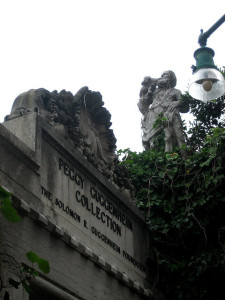The FIAC, the international fair of contemporary art, took place in october in Paris. Its visitors were able to visit a glass cube, the OSNI, placed on top of the Pavilion of the Palais de Tokyo. OSNI stands for Objet Sentant Non Identifié, ‘Unidentified Scented Object’ and was created by Mathilde Laurent, a perfumer for Cartier, along with Munich climate engineers Transsolar.
Visitors entering the cube were able to go up a staircase through a cloud of the Cartier L’Envol (The Flight) perfume. The cloud is clearly seen to viewers outside OSNI. The fact that the perfume can be seen is as important as it can be smelled.
This installation led French magazine Télérama to ask the question: can perfume be a work of art? Modernist called it “[a] true olfactory and immersive artistic work that presents a completely new way of using smell as a medium of creation.”
Wallpaper quotes Mathilde Laurent as saying “I’m not an artist…but…I feel that to create a piece like this is our duty as a house because it’s important that we sustain olfactory art like all others.”
Could OSNI be a work of art? Is there such thing as olfactory art?
Perfume is not protected by French copyright.
Even though article L.112-1 of the Intellectual Property Code clearly provides that its provisions “ protect the rights of authors on all works of the mind, regardless of genre, form of expression, merit or destination,” perfumes are not protected by French copyright, the droit d’auteur. The Cour de Cassation, France’s highest civil court, ruled in 2008 that “the fragrance of a perfume, which proceeds from the simple implementation of a know-how, does not constitute the creation of a form of expression that can benefit from the protection of copyright”. Therefore, L’Envol is not protected by copyright.
However, OSNI is way more than a perfume. It is an art installation, with which visitors are interacting.
Does France protect performance art?
OSNI’s visitors were able to go up and down the staircase inside the cube, and were seen from outside. Were they part of the performance? Were their reactions to the scented air part of the performance?
France recognizes that an artistic performance may be protected, not by copyright law, however, but by the right in one’s image. Reproductions of an artistic performance, such as photographs taken of it, are, however, protected by the droit d’auteur. In that case the performance artist and the photographer are co-authors, Paris Court of Appeals, 4th Chamber B, December 3, 2004.
Is the perfume an element of the protected work, the cube?
If perfume can not be protected as a scent, could it be protected as a work of art? The perfume is clearly seen here, and can be smelled only if one is inside OSNI. Viewers from outside cannot smell it, but they can see the way the cloud of perfume moves inside the cube.
The cube can be considered a sculpture, and, as such, protected by the droit d’auteur. The scent is part of it and thus protected as an element of the sculpture, but still does not gain individual protection. However, one could imagine that if Cartier were to sell OSNI to an art collector, who would then replace the scent with the one of his favorite aftershave, this would be copyright and droit moral infringement, and would conjure the issue of whether perfume is protected by the droit d’auteur out of the (crystal) bottle.
This post was first published on the 1709 Blog.


 New York Attorney. Educated in France and in the U.S. I miss baseball when I am in France and runny cheese when I am in the U.S.
New York Attorney. Educated in France and in the U.S. I miss baseball when I am in France and runny cheese when I am in the U.S. I am a lawyer, and this blog is (mostly) about law, but nothing I write on the blog is legal advice. I hope you’ll find what I write to be of interest, but do not rely on it. For more information, please visit the
I am a lawyer, and this blog is (mostly) about law, but nothing I write on the blog is legal advice. I hope you’ll find what I write to be of interest, but do not rely on it. For more information, please visit the 



